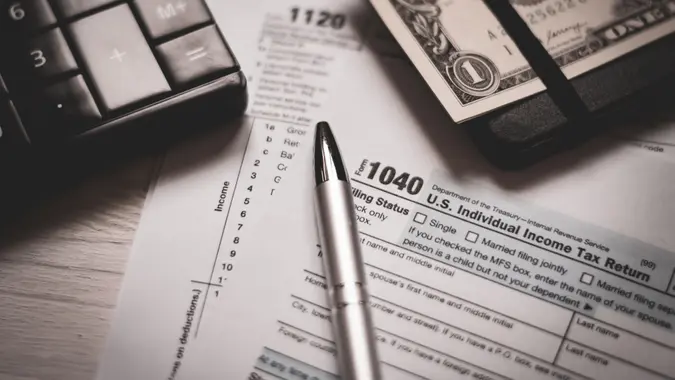The IRS Refunded $303 Billion So Far This Year — Don’t Miss the Oct. 15 Late-File Deadline

Commitment to Our Readers
GOBankingRates' editorial team is committed to bringing you unbiased reviews and information. We use data-driven methodologies to evaluate financial products and services - our reviews and ratings are not influenced by advertisers. You can read more about our editorial guidelines and our products and services review methodology.

20 Years
Helping You Live Richer

Reviewed
by Experts

Trusted by
Millions of Readers
- Over 108 million taxpayers got a tax refund so far this year.
- The IRS has refunded over $303 billion this year as of Aug. 2018.
- If you filed for an extension by April, you have until Oct. 15, 2018, to file.
With the April 17 tax filing deadline long past, most people have already received — and already spent — their refund. Over 108 million refunds have been issued so far in 2018, totaling $303.7 billion as of Aug. 31.
That’s about $1 billion more during the same period in 2017. A total of 111,873,000 refunds were issued by the end of 2017, worth $323.878 billion. The average tax refund this year is $2,793, up $11 from the 2017 average of $2,782.
Click to read more about when to expect your tax refund.
Most People Get a Tax Refund — Did You?
It can be fun to get a tax refund — people often look at it as “found” money and might use the refund to splurge on something they wouldn’t otherwise buy. In 2017, over 73 percent of processed tax returns resulted in a refund.
Consider this though: The nearly $324 billion the IRS paid out in refunds in 2017 was really an interest-free loan from taxpayers. This is money that was withheld from workers’ paychecks and paid out by the IRS months later.
If you don’t want to give the federal government an interest-free loan, you can adjust your withholding allowance so that less money is taken out of your paycheck. Ask your employer for a Form W-4 to change your withholding allowance, and follow the instructions carefully since the Tax Cuts and Jobs Act of 2017 might impact the amount of taxes you will owe. The IRS has a withholding calculator that can help.
Click to keep reading about why 4.5 million people need to adjust their W-4s.
Don’t Miss the October Late-File Deadline
If you filed for an extension by April, your late-filing deadline is Oct. 15. Some people might have more time, such as those who are in the military and serving in a combat zone, or qualified taxpayers who have been impacted by natural disasters.
If you fail to file your taxes on time, you can be assessed a tax penalty, which is usually 5 percent of the unpaid taxes for each month or part of a month past the filing deadline. If you file but don’t pay, the penalty is half of 1 percent of the unpaid amount. So even if you can’t pay, file on time.
Tax Deductions 2018: 42 Tax Write-Offs You Don’t Know About
More on Taxes
 Written by
Written by 

























